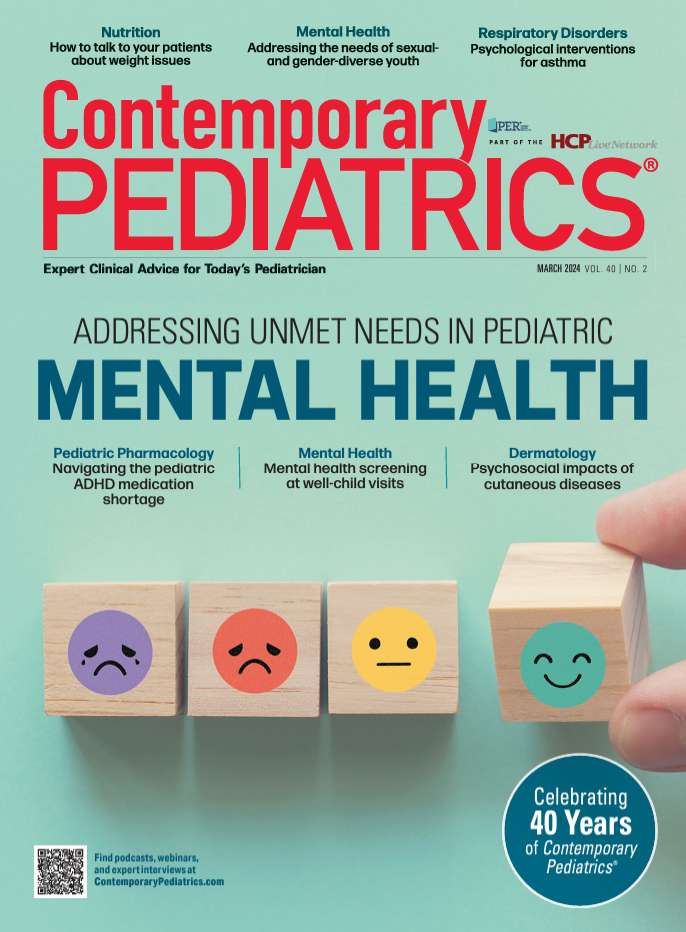What is the psychosocial impact of cutaneous diseases on children?
Health care providers must not only address the physical symptoms of patients with skin disorders but also the psychological fallout frequently associated with these diseases.
Image Credit: © 245989906 - © 245989906 - stock.adobe.com.

Beyond the trying physical repercussion of diseases, cutaneous-presenting diseases can often cause patients psychological burden. Skin diseases such as atopic dermatitis, acne, and psoriasis can become a particular psychosocial burden on afflicted patients mostly because of their high visibility, which can often lead to feelings of stigmatization, stress, anxiety, anger, depression, shame, self-isolation, suicidal ideation, low self-esteem, bullying, and embarrassment in patients.
Skin disease, particularly chronic coniditions, can impact all aspects of the patient’s life, including school, relationships, career choices, social and leisure activities, and sexual life.1,2 Psoriatic disease can especially impact the types of physical activities adolescents engage in, which may negatively contribute to other comorbidities associated with psoriasis, including diabetes, obesity, hypertension, and psychiatric disorders.3
Understanding and addressing the psychological distress and fallout of the patient’s physical illness can be of great help to those with these diseases, and it can help assist their family members and caregivers to weather the storm that such diseases can bring about.
“It is important to address impacts on quality of life secondary to disease severity [and] possible comorbid psychosocial conditions among pediatric patients with acne, atopic dermatitis, and psoriasis—and their families—to cement healthy coping mechanisms and positive self-perception for the future,” said Steven R. Feldman, MD, PhD, professor of dermatology, pathology, and social sciences and health policy at Wake Forest University School of Medicine in Winston-Salem, North Carolina.
Impacting all age groups including infants and children, psoriasis is estimated to affect between 1% and 3% of the global population, with 2% to 4% of the European and North American populations being impacted by the disease.4,5 In approximately one-third of cases, the onset of psoriasis occurs in the first or second decade of life, with a mean age of onset between 8 and 11 years, although the disease may not be diagnosed until the patient has reached adulthood.4-6
Psoriasis is a relatively common autoimmune papulosquamous skin disease that involves T cell–mediated chronic inflammation of the skin. The activated T cells and dendritic cells release cytokines, including TNF-a, IL-17, IL-23, and interferon-g, which causes a cascade of other cytokines, leading to the proliferation of keratinocytes2 and further to the typical clinical presentation of dry, pruritic, erythematous, raised, silvery-white scaly plaques. The disease primarily affects the skin and nails but is also increasingly associated with several comorbidities, including psoriatic arthritis, cardiovascular disease, obesity, diabetes, and psychological aspects such as anxiety, depression, and reduced quality of life.4,7
“There is some reason to believe that psoriasis and obesity have certain links, and there may be greater incidence of obesity in children and adolescents in the United States today. This trend can contribute to an increase in the incidence of psoriasis in some way. However, in my experience, I have not noticed any big change regarding a rise in the incidence of psoriasis in the adult and pediatric patient populations,” Feldman said.
In a recent study,8 investigators looked at and compared the predictors, extent, and impacts of self-stigmatization in patients with psoriasis and atopic dermatitis. The cross-sectional study included 101 patients per indication and included sociodemographic and clinical data as well as patient-reported outcome measures relating to self-stigmatization, depression, anxiety, and quality of life that were analyzed and compared across groups. The group mean comparisons revealed that there were no significant differences in self-stigmatization between patient groups, whereas self-stigmatization significantly predicted symptoms of depression, anxiety, and quality of life in both patient groups. Additionally, the investigators found that current symptoms, not having close social relationships, and lower age were predictors of self-stigmatization in patients with psoriasis, whereas the involvement of sensitive body areas, the sum of previous treatments, and female sex were found to be predictors of self-stigmatization in patients with atopic dermatitis.
Although atopic dermatitis and acne can become a great psychological burden for patients afflicted by all these conditions, Feldman believes psoriasis can be a particular mental burden on patients and can significantly impact their well-being and quality of life due to the strange and often misunderstood nature of its presentation.
Acne can be psychologically disturbing in the sense that it primarily affects the face, which is how we present ourselves to the world. On the other hand, acne is so ubiquitous in our society that it has become more acceptable to have, especially when compared with other diseases and conditions such as psoriasis and more severe cases of atopic dermatitis.
“Among the broad spectrum of cutaneous diseases, severe psoriasis is one of the worst diseases one can have. This common skin disease has such a peculiar presentation, one that many laypeople in society simply cannot wrap their heads around, and this seemingly mysterious disease will make others suspicious and wary of ‘catching’ the disease. Having said that, I do not think children with skin conditions such as acne or atopic dermatitis, particularly for those with milder cases, experience more negative psychosocial outcomes from their disease compared with patients with psoriasis,” Feldman said.
Appropriately addressing the psychological fallout resultant from a patient’s psoriatic disease can prove to be very challenging. According to Feldman, physicians recognize the importance of addressing both the physical and mental symptoms of their patients but are currently not equipped with clear guidelines to manage the long-term psychosocial comorbidities in pediatric dermatologic patients. The Society for Adolescent Health and Medicine’s bullying and peer victimization position paper9 encourages health care providers to take action when they suspect bullying or victimization behaviors, but there is no direct evidence to guide dermatologists and other health care professionals on how to proceed.10
The National Psoriasis Foundation (NPF) is one valuable resource hub that offers a variety of age-appropriate reading materials and tools ranging from comic books and other reading materials on psoriasis to informative brochures and starter kits for the parents and teachers of children with psoriasis. According to Feldman, the informative tools that the NPF offers can be of great help to patients, parents, caregivers, and health care providers, helping them to better cope with and endure the many challenges associated with treating and managing patients of all ages with psoriatic disease.
“Before we had drugs that regularly cleared psoriasis, patients would say that the [NPF] was their most helpful tool to help them with their psoriasis. Knowing about and using the resources from the NPF and learning about how other people deal with their disease has been extremely helpful to my patients [with psoriasis],” Feldman said.
When addressing the psychological aspects of patients with psoriasis during the consultation, Feldman said that it is crucial to be very open with patients, speak with them in a noncondescending manner, and, above all, to actively listen to their patients’ issues and concerns without interrupting them. Health care providers can speak candidly with their patients and let them know that they are not alone with their disease, that psoriasis is not contagious, and that psoriatic flares will likely occur throughout their lives.
Fortunately, however, continued research has borne new treatment options that can very effectively address the symptoms of psoriasis in patients. The dawn of revolutionary medications such as etanercept (Enbrel; Amgen) and adalimumab (Humira; AbbVie), as well as other medications like IL-17/IL-23–blocking agents have changed the therapeutic landscape for patients of all ages with psoriasis.
“There are great treatments that are available now that are very effective and [are] safer than what we used to have available for our patients of all ages [with psoriasis]. Adhering to the prescribed treatment is also incredibly valuable, and to whatever extent patients are not following the treatment plan, they would do well to communicate this to their health care providers and let them know so an appropriate treatment can be planned accordingly,” Feldman said.
According to Feldman, education is one of the key points in helping to treat and manage patients with psoriasis and is paramount in assisting patients live with their disease. Health care providers can help guide their patients toward helpful organizations such as the NPF resource center, where they can learn how other people with psoriasis deal with their disease and be part of a growing community that shares their personal journey and experiences with psoriasis.
Physicians can also help connect their pediatric patients with psoriasis with other children who have the same disease, as well as direct them to online self-help groups to help them feel less isolated. Online forums can be particularly useful in this regard, as they can help eliminate the stress of appearance, and the anonymity can help patients express their feelings and concerns more freely.
“A successful psoriasis treatment and management approach not only involves controlling the physical symptoms of the disease but also the implementation of a number of psychosocial interventions to help patients build resilience and a positive self-perception, which can lead to an improved quality of life and their ability to face the many challenges associated with their disease,” Feldman said. “Of course, clearing up the psoriasis completely with one of the new treatments makes that a whole lot easier.”
Click here for more from the March mental health issue of Contemporary Pediatrics.
References:
1. Jafferany M, Pastolero P. Psychiatric and psychological impact of chronic skin disease. Prim Care Companion CNS Disord. 2018;20(2):17nr02247. doi:10.4088/PCC.17nr02247
2. Kelly KA, Balogh EA, Kaplan SG, Feldman SR. Skin disease in children: effects on quality of life, stigmatization, bullying, and suicide risk in pediatric acne, atopic dermatitis, and psoriasis patients. Children (Basel). 2021;8(11):1057. doi:10.3390/children8111057
3. Gonzalez J, Cunningham K, Perlmutter J, Gottlieb A. Systematic review of health-related quality of life in adolescents with psoriasis. Dermatology.2016;232(5):541-549. doi:10.1159/000450826
4. Relvas M, Torres T. Pediatric psoriasis. Am J Clin Dermatol. 2017;18(6):797-811. doi:10.1007/s40257-017-0294-9
5. Bronckers IM, Paller AS, van Geel MJ, van de Kerkhof PC, Seyger MM. Psoriasis in children and adolescents: diagnosis, management and comorbidities. Paediatr Drugs. 2015;17(5):373-384. doi:10.1007/s40272-015-0137-1
6. Dhar S, Srinivas SM. Psoriasis in pediatric age group. Indian J Dermatol. 2022;67(4):374-380. doi:10.4103/ijd.ijd_570_22
7. Kang BY, O’Haver J, Andrews ID. Pediatric psoriasis comorbidities: screening recommendations for the primary care provider. J Pediatr Health Care. 2021;35(3):337-350. doi:10.1016/j.pedhc.2020.12.006
8. Schlachter S, Sommer R, Augustin M, Tsianakas A, Westphal L. A comparative analysis of the predictors, extent and impacts of self-stigma in patients with psoriasis and atopic dermatitis. Acta Derm Venereol. 2023:103:adv3962. doi:10.2340/actadv.v103.3962
9. Eisenberg ME, Aalsma MC; Society for Adolescent Medicine. Bullying and peer victimization: position paper of the Society for Adolescent Medicine. J Adolesc Health. 2005;36(1):88-91. doi:10.1016/j.jadohealth.2004.09.004
10. Nicholas MN, Gooderham M. Psoriasis, depression, and suicidality. Skin Therapy Lett.2017;22(3):1-4.

Recognize & Refer: Hemangiomas in pediatrics
July 17th 2019Contemporary Pediatrics sits down exclusively with Sheila Fallon Friedlander, MD, a professor dermatology and pediatrics, to discuss the one key condition for which she believes community pediatricians should be especially aware-hemangiomas.
Recognize & Refer: Hemangiomas in pediatrics
July 17th 2019Contemporary Pediatrics sits down exclusively with Sheila Fallon Friedlander, MD, a professor dermatology and pediatrics, to discuss the one key condition for which she believes community pediatricians should be especially aware-hemangiomas.
2 Commerce Drive
Cranbury, NJ 08512
All rights reserved.